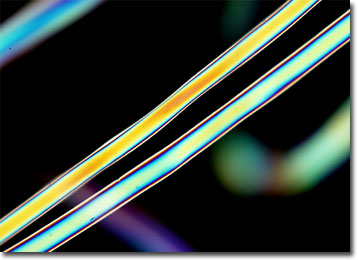Polarized Light Microscopy Digital Image Gallery
Cuprammonium Rayon Fibers
One of the most popular synthetic fibers produced today, when rayon first emerged on the textile market in the late 1800s, it was marketed as “artificial silk.” However, by 1924, the term rayon was coined to describe this cellulose-derived regenerated fiber.

View a second image of Cuprammonium Rayon Fibers
Cuprammonium rayon, which is the variety that most closely resembles silk, was invented in 1890. The fiber is made through a process that involves dissolving the cellulose from wood pulp or cotton linters in a solution of copper oxide and ammonia, and then forcing the substance through a spinneret so that it is extruded in filaments that undergo stretch spinning. The result is a lustrous, very fine yarn that can be utilized to create sheer, lightweight fabrics with superior draping qualities, as well as hosiery. This variety of rayon is often more familiarly known by the trade name Bemberg.
Despite the luxurious qualities of cuprammonium rayon, the most commercially important variety of rayon is viscose rayon. This fiber, which was developed by a group of British scientists only a year after the cuprammonium type was first created, involves treating the cellulose with sodium hydroxide followed by carbon disulfide to create cellulose xanthate. This substance is then re-exposed to sodium hydroxide, in which it dissolves into a viscous fluid that can be forced through a spinneret. The strands that emerge are solidified by exposure to a coagulating bath. Viscose rayon is commonly found in a wide variety of clothing, often in blends, as well as in carpeting and other textiles for the home.
